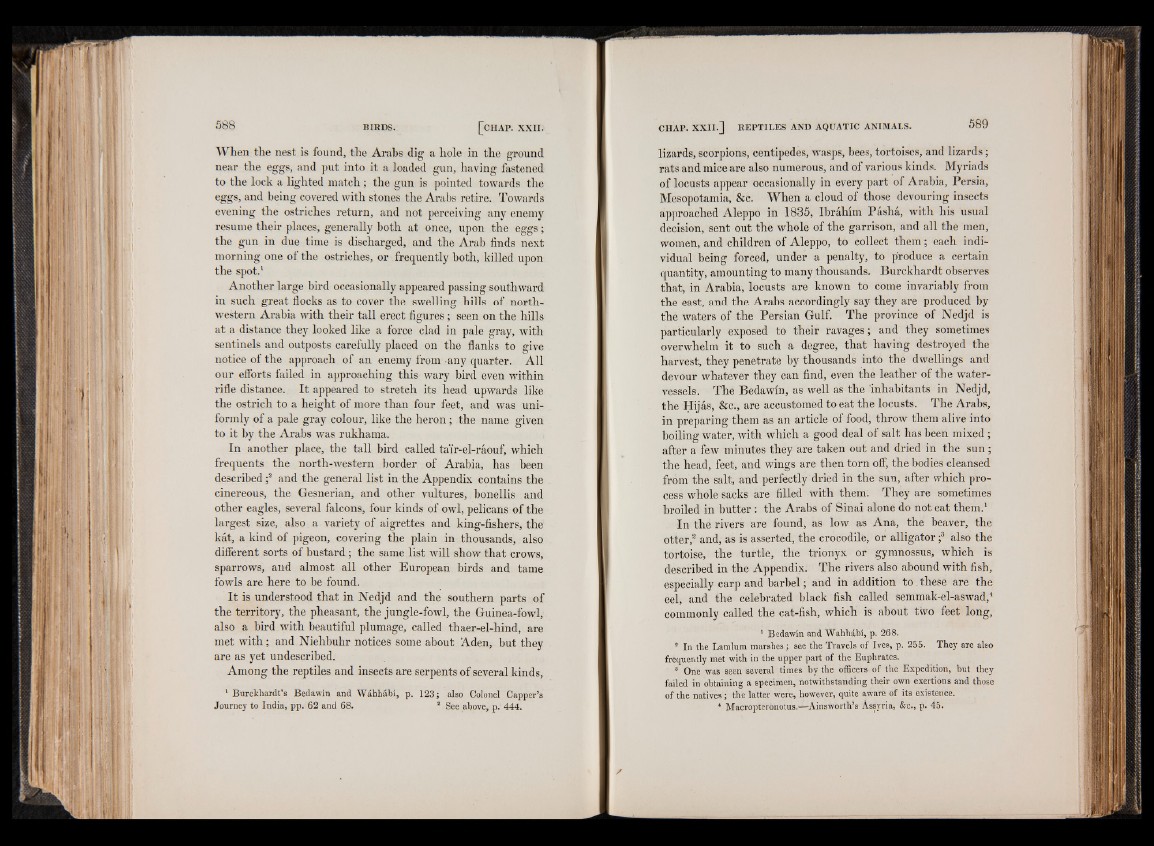
When the nest is found, the Arabs dig a hole in the ground
near the eggs, and put into it a loaded gun, having fastened
to the lock a lighted match; the gun is pointed towards the
eggs, and being covered with stones the Arabs retire. Towards
evening the ostriches return, and not perceiving any enemy
resume their places, generally both at once, upon the eggs;
the gun in due time is discharged, and the Arab finds next
morning one of the ostriches, or frequently both, killed upon
the spot.1
Another large bird occasionally appeared passing southward
in such great flocks as to cover the swelling hills of northwestern
Arabia with their tall erect figures ; seen on the hills
at a distance they looked like a force clad in pale gray, with
sentinels and outposts carefully placed on the flanks to give
notice of the approach of an enemy from any quarter. All
our efforts failed in approaching this wary bird even within
rifle distance. It appeared to stretch its head upwards like
the ostrich to a height of more than four feet, and was uniformly
of a pale gray colour, like the heron; the name given
to it by the Arabs was rukhama.
In another place, the tall bird called tair-el-raouf, which
frequents the north-western border of Arabia, has been
described f and the general list in the Appendix contains the
cinereous, the Gesnerian, and other vultures, bonellis and
other eagles, several falcons, four kinds of owl, pelicans of the
largest size, also a variety of aigrettes and king-fishers, the
kat, a kind of pigeon, covering the plain in thousands, also
different sorts of bustard; the same list will show that crows,
sparrows, and almost all other European birds and tame
fowls are here to be found.
It is understood that in Nedjd and the southern parts of
the territory, the pheasant, the jungle-fowl, the Guinea-fowl,
also a bird with beautiful plumage, called thaer-el-hind, are
met with; and Niehbuhr notices some about Aden, but they
are as yet undescribed.
Among the reptiles and insects are serpents of several kinds,
1 Burckhardt’s Bedawin and Wahhabi, p. 123; also Colonel Capper’s
Journey to India, pp. 62 and 68. ! See above, p; 444.
lizards, scorpions, centipedes, wasps, bees, tortoises, and lizards;
rats and mice are also numerous, and of various kinds. Myriads
of locusts appear occasionally in every part of Arabia, Persia,
Mesopotamia, &c. When a cloud of those devouring insects
approached Aleppo in 1835, Ibrahim Pasha, with his usual
decision, sent out the whole of the garrison, and all the men,
women, and children of Aleppo, to collect them ; each individual
being forced, under a penalty, to produce a certain
quantity, amounting to many thousands. Burckhardt observes
that, in Arabia, locusts are known to come invariably from
the east, and the Arabs accordingly say they are produced by
the waters of the Persian Gulf. The province of Nedjd is
particularly exposed to their ravages; and they sometimes
overwhelm it to such a degree, that having destroyed the
harvest, they penetrate by thousands into the dwellings and
devour whatever they can find, even the leather of the water-
vessels. The Bedawin, as well as the 'inhabitants in Nedjd,
the Hijas, &c., are accustomed to eat the locusts. The Arabs,
in preparing them as an article of food, throw them alive into
boiling water, with which a good deal of salt has been mixed;
after a few minutes they are taken out and dried in the sun;
the head, feet, and wings are then torn off, the bodies cleansed
from the salt, and perfectly dried in the sun, after which process
whole sacks are filled with them. They are sometimes
broiled in butter; the Arabs of Sinai alone do not eat them.1
In the rivers are found, as low as Ana, the beaver, the
otter,2 and, as is asserted, the crocodile, or alligator ;3 also the
tortoise, the turtle, the trionyx or gymnossus, which is
described in the Appendix. The rivers also abound with fish,
especially carp and barbel; and in addition to . these are the
eel, and the celebrated black fish called semmak-el-aswad,4
commonly called the cat-fish, which is about two feet long,
1 Bedawin and Wahhabi, p. 268.
8 In the Lamlum marshes; see the Travels of Ives, p. 255. They are also
frequently met with in the upper part of the Euphrates.
3 One was seen several times by the officers of the Expedition, but they
failed in obtaining a specimen, notwithstanding their own exertions and those
of the natives; the latter were, however, quite aware of its existence.
* Macropteranotus.—Ainsworth’s Assyria, &c., p. 45.